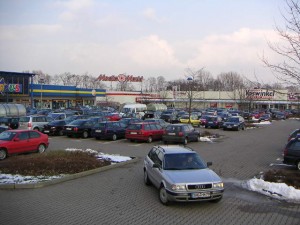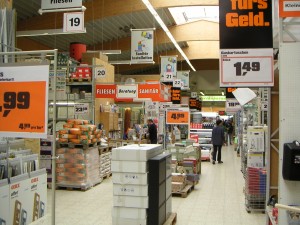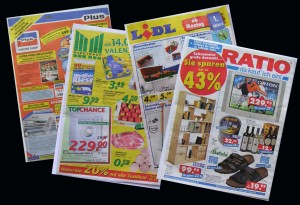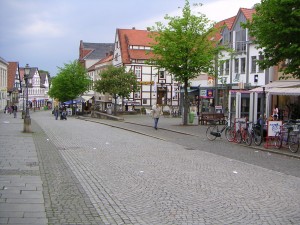Germany is continuously growing into a consumer market that mirrors many of the traits of US consumers. As the strongest economy in Europe it could be a good fit for consumer product manufacturers to expand their reach, or a place for aggressive retailers looking to branch out beyond the bounds of the USA.
(this original article, written in 2008 is being updated)
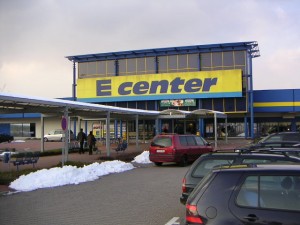 Now more than ever Germans are growing into more educated and compulsive consumers. Every week their newspapers get thicker and heavier as advertising and inserts increase. Television is getting more congested with both branded product advertising and more regional retailer ads. The mailman, who could often pass by many households, now has to make regular stops with direct mail offers and specials from local stores. Retail shelves once listing only the current prices are now cluttered with hangtags and bold color discount offers to encourage German consumers to buy now. Even in the home, once immune to any phone calls other than friends and relatives are occasionally receiving telemarketing offers. Even cell phones are getting calls. And, Germany still has a variety of door-to-door sales people, peddling premium products and services.
Now more than ever Germans are growing into more educated and compulsive consumers. Every week their newspapers get thicker and heavier as advertising and inserts increase. Television is getting more congested with both branded product advertising and more regional retailer ads. The mailman, who could often pass by many households, now has to make regular stops with direct mail offers and specials from local stores. Retail shelves once listing only the current prices are now cluttered with hangtags and bold color discount offers to encourage German consumers to buy now. Even in the home, once immune to any phone calls other than friends and relatives are occasionally receiving telemarketing offers. Even cell phones are getting calls. And, Germany still has a variety of door-to-door sales people, peddling premium products and services.
According to the US Government, Germany accounts for roughly one-third of the European Union’s GDP. Despite this, the economic situation in Germany is hardly robust. Wall Street Journal reports retail sales only up 1.5% last January and economists forecast a 1.5% growth throughout 2006. This slow growth is impressive considering unemployment rates hovering in the 9% range and the government has major debt issues to deal with. The unemployment is part of the adjustment as Germany re-distributes much of their manufacturing base due to the same pressures that many other countries face as they try to compete on the world market. Manufacturers are dealing with high union contracts, wage and benefit rates by moving production to the nearby eastern block countries where workers are more enthusiastic for a job at any wage. It is a very similar situation to what happened in the US in the 60’s, 70’s and 80’s and continues to a smaller extent today as manufacturers in the USA moved production to Mexico, Canada and now Asia and India. Just as the US has adjusted its economy to service oriented, so should Germany as its education process changes to train students for the service sector.
A significant point to consider is how Europe as a whole is growing into a consolidated major retail trade zone. With the addition of 10 countries into the European Union, trade between these countries will expand and German retailers will grow in these new countries, finding more customers with growing incomes, as their economies expand. Manufacturers that build relationships in Europe and retailers that establish a foothold now, will be positioned for world wide stability in the future along with the potential for significant growth. This article was written in 2008-9. General Marketing Service can provide further updated insight on the German retail marketplace upon request.
The Maturing Marketplace
Despite the negative vision the unemployment figures may portray, and flat or slightly declining retail sales in 07’, the German retail landscape continues to evolve with updated independent stores and growing chains. Some stores/chains evolution mirror the 70’s and 80’s retail growth and consolidation as it happened in the USA. Also, in Germany, there are also some unique retail marketing models that are not as evident in the States. Comparing the two countries offers lessons to be learned on both sides of the Atlantic. While the city centers in Germany continue to be the hub for most retail transactions, strip centers and the German version of the “big box” is cropping up in city perimeters. These stores, with their advertised lower prices and wider selections are having the same effect they had in the USA years ago, of pulling many consumers out of town and eventually closing some independent retailers located in the city center.
Shopping hours are significantly limited in Germany compared to what US consumers are used to. On weekdays stores normally open at 10am and close at 6 to 8pm. Many smaller independent stores in smaller cities close for 2 hours at midday and reopen at 2 or 3 pm. For the most part there is no shopping on Sundays at any store, unless you have a special government permit (usually granted for special circumstances.). These rules limit the amount of time consumers can spend shopping and thus result in consumers buying less. For good or for bad (depending on which Germans you talk to) the trend to longer store hours is growing and this should help retail sales.
Service levels at many German retail stores are improving but do not appear to be at the level of the demanding US consumer. In most German retailers you can find less people on the floor, less cash registers open and less help when you need it. In the USA it’s common for a sales representative to ask, “can I help you” where that is a much rarer occurrence in Germany. It’s not unusual to walk into a small store, shop around for several minutes and walk out with no one uttering a word to you. It’s hard to determine if this is a training issue or a cultural trait. Despite the lack of an aggressive sales person, product knowledge among sales people appears to be good. In the case of electronic goods, most sales clerks have been trained on features and benefits and once approached are very willing to explain a product or demonstrate its operation.
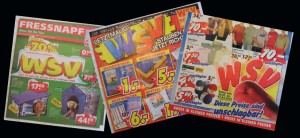
Only 2 Sale Periods per year
The concept of a regular sale or continued discounting is new to the German consumer. Prior to 2003 retailers were only allowed to have 2-3 government sanctioned clearance or sales events unless they had an honest reason for the sale (i.e. closing, disaster, or special circumstances). An example of a sanctioned sales is “WSV” (Winter Schluss Verkauf: translated means Winter Sale) which is a post Christmas holiday clearance period traditionally run at the end of January and required to start and end on specific dates. This limited discount price policy has faded over the past few years and regular sale offers are commonplace these days. Still many stores promote heavily for the WSV season.
The Maturing Consumer
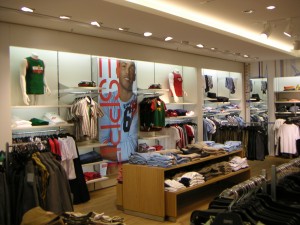
Excellent Merchandising in Esprit Shop
The German consumer faces many of the same pressures that the American consumer has to deal with. With pay increases very low, ever increasing taxes and demands from health and other social services, the German consumer has had to limit spending. When the Euro is tight, spending is down, but as the economy rebounds and jobs, wages and confidence builds, sales grow. The German process mirrors the USA very closely although growth and slumps may not always be in sync between the US and Europe.
German consumers appear to be much less brand driven than US consumers. Success of private labels is just as evident as nationally advertised products and in many cases a store brand will outsell the national brand. The way the stores advertise and stand behind their products promotes German consumers to stick with the store as a measurement of quality just as easily as they might stick with a brand. The German consumer is much more accustomed to paying the suggested price for an item. The portion of a store dedicated to sales appears to be about 10-15% (on average), so there are simply less items marked on sale in the store. Also, day-to-day items (non promotional goods) are less likely marked down and product clearances are much less available than in US retailers.
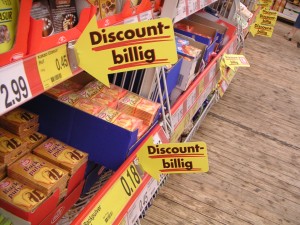 As mentioned in the previous section, the concept of sale-prices is growing. But that doesn’t mean the German consumer reacts the same way as the US consumer. Last holiday season the German consumer was exposed to retailer’s streams of sale after sale, and reports from the German retail trade association (BAG) explain “consumers became disinterested with the sales after a certain period of time and didn’t respond to them.”
As mentioned in the previous section, the concept of sale-prices is growing. But that doesn’t mean the German consumer reacts the same way as the US consumer. Last holiday season the German consumer was exposed to retailer’s streams of sale after sale, and reports from the German retail trade association (BAG) explain “consumers became disinterested with the sales after a certain period of time and didn’t respond to them.”
Even the steady increase in store hours can be traced back to German consumer demand, as both members of the household begin working and the need to shop at after work and on weekends more often. It’s evident that German retailers cannot immediately adapt to all US retail traits and policies and need to research their own markets to determine what works best regarding products, sales and other store policies.
The Changes In The Marketplace
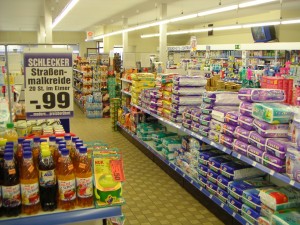 Currently, It is hard to determine who is the driving force of change in the German retail marketplace, the younger more aggressive consumers or the chain retailer? One thing is for sure, the retail situation is changing, but whether it is for the better or not depends on whom you talk to about it. It’s a change that is causing concern for many Germans who do not want to see the traditional retail situation change.
Currently, It is hard to determine who is the driving force of change in the German retail marketplace, the younger more aggressive consumers or the chain retailer? One thing is for sure, the retail situation is changing, but whether it is for the better or not depends on whom you talk to about it. It’s a change that is causing concern for many Germans who do not want to see the traditional retail situation change.
The changes happening are numerous, here are a few examples: Store size is increasing; display and merchandising is improving towards US levels; hours are increasing; signs and fixtures are improving; the type and variety of store styles is increasing; the variety of merchandise is increasing; the number of brands and product choices within a given store are increasing; marketing and advertising is improving; and store policies are changing to adapt to consumer habits.
One segment that is slow in making these changes is the independent retailer. While there are some exceptions most independents are sluggish to adapt to the transformation in the retail marketplace. The current predominance of independents in smaller towns is probably the main reason German retail traditions have held on so long. This lack of adaptation to changing trends may account for small retailers being the majority of the 4,500 retailers that went bankrupt in 2003.
What Can You Get?
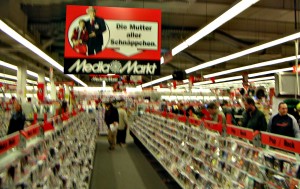 The merchandise in German stores closely resembles what is seen in stores in the United States with similar store department breakouts to what US retailers are offering. Housewares, tools, electronics, jewelry, stationery, food, toys and gifts are some of the standard departments. There are some differences though; in general German consumers are not subject to the many styles and choices within a department or product category. Although mentioned in earlier paragraph that the number of choices is growing, German’s still don’t have the depth of choice Americans do.
The merchandise in German stores closely resembles what is seen in stores in the United States with similar store department breakouts to what US retailers are offering. Housewares, tools, electronics, jewelry, stationery, food, toys and gifts are some of the standard departments. There are some differences though; in general German consumers are not subject to the many styles and choices within a department or product category. Although mentioned in earlier paragraph that the number of choices is growing, German’s still don’t have the depth of choice Americans do.
Many major brands are available in Germany. The list is too long to mention. What is different is the lack of locations that major brands are available. A city of 50,000 might have one or two big box type stores and 2-3 more specialty stores that carry a certain type of product. This may change as German superstores continue to expand and US general retailers such as Wal-Mart or Staples continue to expand through the country.
As mentioned earlier, Germans appear to be less brand loyal and less brand driven than US consumers. This is evident by the larger number of unadvertised brands or private label brands that appear in store displays and in ads. A quality licensed brand can do well. Germany has been a much easier market for new coming electronic brands such as Medion and Aiptek to break into. The reason for this could be because of the German shopper’s loyalty to the store as quality insurance. In other words, if the store stocks the product, it must be worthy of their consideration.
Clothing is one of the categories where Germany (and Europe) have many strong brands of their own. Tools, housewares, foods, furniture, office products, and auto supplies are other areas of much independence from US brands. The bottom line here is there is room for more brands and with the right amount of marketing and advertising a US brand could become a leader in Germany.
Product style is also something potential sellers should consider. While Germany tracks similar to the US in many style choices, they also give their own twist to many products, which may be why some companies that have tried to sell items in Germany in the past have not been successful. Such categories as vacuum cleaners, bedding, lighting and clothing are some items where the most popular styles differ from what are bestsellers in the US.
Food plays such a vital role in German retailing that as far as merchandise goes, would require a complete review of its own idiosyncrasies. That being said, the Germans’ diet is highly similar to that of the US, although slightly healthier, and it seems that almost any food item sold in the US would be considered (tried) by German consumers, with the right amount of marketing support, of course. In general that plays true for most US products not found in Germany. It seems almost anything could succeed with the right marketing effort.
I Get The Message
Regarding retail advertising and marketing, one might consider the Germans lucky that they have not reached the degree of marketing tactics found in the US. As with other retail related matters, that appears to be changing, resulting in advertising and marketing playing an increasingly larger role in German retailing. As in the US, television is the number one medium, and is much more available in Germany. Since about 90% of Germans with a TV have cable or satellite, advertisers automatically have at least 20 choices of stations to reach the complete audience. Of course there are network type stations, but they don’t have the dominance that the over- the-airwave networks have in the US. With the country’s smaller size, it’s much easier to advertise nationally in Germany, assuming you have the distribution to go with it.
With Germany being such a car-loving nation one would think radio would be a strong part of an advertising plan, however Germans are lucky to find very minor radio advertising over the airwaves resulting in more music, talk or the very regular traffic reports. Since huge national networks don’t manage radio in Germany, as it is in the US, the radio programs, shows and advertising is predominantly regional. Newspapers are strong in Germany. There are both local and national choices for advertisers to choose from. As with television and radio they are much less cluttered than their US counterpart. Roughly 50% of the US volume of advertising appears in the daily local paper in Germany. That makes it easier for a marketer to make a big impact when they run consistent, or larger advertising.
Newspaper inserts (and mailing delivery) are a strong and growing trend in German retail advertising. While they are nothing compared to the often inch-thick portion of flyers a typical US consumer can come to expect on a Sunday morning, the Germans are finding thicker and thicker newspapers because of these inserts. As with the US, flyer designs can vary by retailer and in some cases production quality suffers, but in general German retailers have this channel of marketing well in hand. With the lifting of national rules and guidelines covering sales and discounting the retail chains in Germany are using the weekly newspaper insert to launch new products in their store, drive traffic with sales and discounts and build brand awareness and loyalty.
Direct mail has been another budding marketing tool. As few as 10 years ago it was rare for a German household to get any other mail in their box but bills and letters. Now direct mail appears on average of every other day or more (depending on your location). The mailman may deliver additional copies of the newspaper inserts, offers from national companies, or regional promotions from independent retailers. As in the US, independent retailers may often be supplied mailers by a national supplier or distributor and then imprint the independent retailer’s prices and details on the piece.
 Promotional events are a rare occurrence. Occasionally independents run “anniversary sales” or similar events but nowhere near the scale that is seen in the US. This results in most promotional events really working because they are honest events, which consumers respond to. Some retail categories have adapted quickly to Internet advertising. Travel, cell phones, catalogers and of course sex web pages clutter the typical German’s computer screen via pop-up and banner advertising along with e-mail spammers. This is one medium where the German consumer hasn’t been so lucky as to escape the advertising clutter found in the US.
Promotional events are a rare occurrence. Occasionally independents run “anniversary sales” or similar events but nowhere near the scale that is seen in the US. This results in most promotional events really working because they are honest events, which consumers respond to. Some retail categories have adapted quickly to Internet advertising. Travel, cell phones, catalogers and of course sex web pages clutter the typical German’s computer screen via pop-up and banner advertising along with e-mail spammers. This is one medium where the German consumer hasn’t been so lucky as to escape the advertising clutter found in the US.
Outdoor advertising is very light and usually reserved for some local establishment using and outdoor sign to point the way to their local store. Highway billboards are almost predominantly illegal and probably one of the reasons why the Germany countryside is still so beautiful. And finally, on advertising, a funny thing happened on the way to the movies, the theater played over 30 minutes of advertising before the actual film began. These ads are usually done by national brands or programs. The only good point to that is it almost eliminates the chances of you being late for the film.
Where Can I Get That?
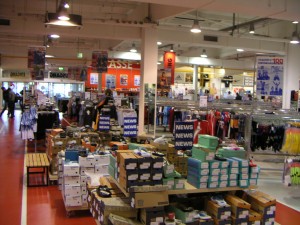 There are not many product categories you can’t find in Germany. They show up eventually at 4 main types of stores, many of those resemble their US counterpart. The independent retailer, the largest segment, often offers some unique and hard to find merchandise, but along with that come inconsistent product selection and cluttered floor plans, similar to the mom and pop stores across the US. These smaller stores often set up elaborate displays in front of their stores to gain the downtown street side walkers. Inside the stores are usually small and packed full of merchandise. The grocery category is by far the most unique and intriguing in Germany. On average a grocery stores in Germany is about 50% of the size (Sq.ft.) of the average US grocery store. This, of course limits the number of items inside and in popular categories may limit the number of brands. There are two types of grocery stores. The standard food and personal items style, which resembles what the US consumer would call the typical grocery store.
There are not many product categories you can’t find in Germany. They show up eventually at 4 main types of stores, many of those resemble their US counterpart. The independent retailer, the largest segment, often offers some unique and hard to find merchandise, but along with that come inconsistent product selection and cluttered floor plans, similar to the mom and pop stores across the US. These smaller stores often set up elaborate displays in front of their stores to gain the downtown street side walkers. Inside the stores are usually small and packed full of merchandise. The grocery category is by far the most unique and intriguing in Germany. On average a grocery stores in Germany is about 50% of the size (Sq.ft.) of the average US grocery store. This, of course limits the number of items inside and in popular categories may limit the number of brands. There are two types of grocery stores. The standard food and personal items style, which resembles what the US consumer would call the typical grocery store.
Next there is the hybrid small grocery store. This concept is unique from what is normally seen in the US and offers some great marketing insight for US grocers. The hybrid small store, for example, can be a 12000 square meters, free standing building, with 66% of its merchandise being made up of food items, and 33% of its items being made up of weekly promotional specials that are normally advertised in a newspaper ad or insert. What is unique about this part of the merchandising and marketing is the large diversity of product mix featured in this display of non-food items. Everything from laptop computers to shoes, sox, and bike accessories to seasonal decorations. One might argue that it’s nothing new and had been done in the US. However these small grocery stores with customers walking out with a head of lettuce and a 17” computer monitor is a unique model especially considering the size of the store. These small stores eliminate the displays and merchandising of a typical big box store. There is no help available for questions and items must be self-explanatory or feature instructive packaging. The help is limited to one or two checkout people. Product stock is limited to what is on the floor and when the store runs out, they’re out. No rain checks or special efforts are made to satisfy the late shopping consumer. Also there are very few brand names featured in these durable product areas. This weekly merchandise change-out would be an opportunity for a US company with a lesser-known brand to break into this market.
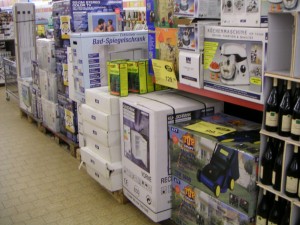 The big box store concept is one that Germans appear to be readily embracing, resulting in the steady growth of larger stores and increasing floor plans. You can find them in many flavors, general merchandise, DIY, home products and electronics. Although sizes can vary, a German general-merchandise big box store is about half the size of a typical Target store found in the US. The electronics stores are more similar and in many cases offer a greater selection than found in a typical US electronics store. If you live in Germany and want variety of choice within a category, you would need to shop at one of these big box stores. Of course there are some independents with a variety but its much less likely than within the larger box superstore.
The big box store concept is one that Germans appear to be readily embracing, resulting in the steady growth of larger stores and increasing floor plans. You can find them in many flavors, general merchandise, DIY, home products and electronics. Although sizes can vary, a German general-merchandise big box store is about half the size of a typical Target store found in the US. The electronics stores are more similar and in many cases offer a greater selection than found in a typical US electronics store. If you live in Germany and want variety of choice within a category, you would need to shop at one of these big box stores. Of course there are some independents with a variety but its much less likely than within the larger box superstore.
Other than size, the layout and fixturing of a big box store in Germany resembles what you would see in the US. Display signs, merchandising and lighting still lag behind their US counterpart, but it is improving thanks to branded manufacturers supplying displays and pushing for a better image. Sales help can vary but in general, as mentioned earlier, less help, but better trained help. The grocery and big box stores are the ones most likely to be sending out the newspaper inserts and consistent direct mailings featuring a new host of weekly products. On a weekend, any one of the Germany electronics superstores is equally as packed as the local Best Buy would be in the US. There are also many single category stores that are chain stores. Whether you want clothing, shoes, music, jewelry, sporting goods, DIY or any other category, there is most likely a specialty store chain that sells it. There are German chains, European chains and International chains throughout most German cities of 20,000 people or more.
The Changing Location Retailscape
The location of each of these stores mentioned above are creating some changes in the German landscape the makeup of the city and how the consumer shops. As was in the US pre 1965, people would travel to their city’s downtown and shop at the various retailers that lined main street. As strip shopping centers popped up, they drew customers away from the city’s center because customers liked the convenience of not having to travel as far to shop. Probably the deathblow to most major city’s downtown shopping areas was the shopping mall. A city unto itself with everything a customer needed in a warm comfortable environment.
Germany faces some of these same trends today. One time vibrant city centers are seeing more closed store-fronts and less daily traffic as chain based stores migrate outside of the downtown, to freestanding locations, with their cheaper land costs, convenient parking and room for expansion. More strip shopping centers are forming and even indoor shopping malls are cropping up in a very few locations.
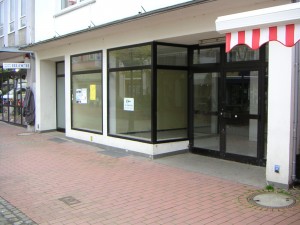 It’s hard to tell if Germany will follow the same path as US retail when it comes to retail migration from downtowns to the suburbs, but as the larger chains continue to grow and build away from the city, so goes the consumer’s euros. The city planners are going to need to do more to draw consumers back to the city center. As it is now the city center retailer’s focus on clothing, jewelry, pharmacies, and other personal items while the outer areas are where the groceries and chain stores are building.
It’s hard to tell if Germany will follow the same path as US retail when it comes to retail migration from downtowns to the suburbs, but as the larger chains continue to grow and build away from the city, so goes the consumer’s euros. The city planners are going to need to do more to draw consumers back to the city center. As it is now the city center retailer’s focus on clothing, jewelry, pharmacies, and other personal items while the outer areas are where the groceries and chain stores are building.
Its All There
In many ways the German retail situation is very mature, especially when compared to the rest of the world. For a US product manufacturer it has all the desired attributes for maximizing product sales potential. Germany would make a good first start to selling in the European Union. Its economy is the largest of the EU, even if it is quite stagnant at the moment; it is still full of consumers with good incomes that are ready to buy. The government is easing restrictions for retailers and that sets the stage for increased retail growth in the future.
Germans as consumers are also changing. The older conservative consumer is giving way to a younger consumer willing to risk more debt to acquire the things he/she wants.
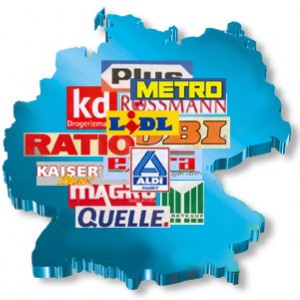 While most mainstream products in every category can be found on the shelves in German stores there is plenty of room for additional entries and brands.
While most mainstream products in every category can be found on the shelves in German stores there is plenty of room for additional entries and brands.
With less brand loyalty, so far, there is plenty of opportunity to establish a brand name in Germany and with over 50,000 chain retail outlets, not to mention the many independents, there are plenty of places to establish that brand. Since displays are rarer, a chain might be happy to get a handsome fixture in exchange for launching a product and since retail sales associates are more likely to stay at a store longer than in the US, your training will pay off.
Of course there are plenty of hurdles to overcome. Language and packaging to begin with, testing and dealing with returns, quality, shipping, ordering and warehousing issues. But, if you’re willing to jump the hurdles, the rewards could be rich. Most recently the European Union added 12 new countries to their family. Now with borders open, commerce will expand and economies will grow. As Europe grows and prospers, their consumers could someday carry the same power as the US consumer. Germany, with its more mature base of consumers and retailers is an excellent starting point in which to build relationships and continue to grow US products and brands beyond our borders.
The Players
The following is a summary of the major players in German mass merchandise retailing and a short sentence to describe them. These would be the places to contact if you want to expand your product distribution into Germany.
Aldi: One of the pioneers of the small box grocery and mixed-merchandise stores. A leader with over four thousand stores and 25 billion (eu) in sales.
Bahr; Medium and Big Box DIY stores with tool, supplies and home and garden merchandise
Edeka; Began as a small grocery chain and now includes medium sized hybrid stores in city locations They now have over 1000 stores in 3-4 levels of store size and merchandise depending on the location.
Extra; Primarily a grocery store with about 25% mass merchandise goods.
Expert; Medium and big box electronics superstore
Globus; Warehouse theme general merchandise
Hagebaumarkt; DIY store with home accessories, tools, garden
Hornbach; Big Box DIY stores with tool, supplies and home and garden merchandise, running regular tv advertising
Jawoll; Medium size closeout stores with food and mixed general merchandise
Kaufland; Primarily Grocery store chain
Kodi; Smaller sized closeout chain often found in city centers.
KD Drogeriemarkt; Drug store with personal items along with some food, clothes, toys, general merchandise.
Lidl; Hybrid grocery store with over 1500 locations. Strong competitor to Aldi with ownership of other retail chains
Markant; Grocery Store with focus on high quality meats and produce
Marktkauf Home +
Marktkauf; Hybrid Grocery Store with 50/50 split of food and general merchandise including many regularly stocked items.
Media Markt; Big Box Electronic Retailer
Metro & Makro; Flagship grocery stores for the MetroAG giant holding group.
Obi; Medium size DIY store with over 400 stores. Sells supplies, tools, lighting, home, garden and more.
Plus; Hybrid grocery store with over 2500 stores. Makes heavy push on web site for higher priced items.
Porta; Large furniture store with 25% focus on home accessories and general home merchandise as might be seen in Bed Bath Beyond.
Quelle; Cataloger with over 5000 distribution stores. Store sizes vary from tiny to Rite Aid sized. Consumers mostly buy from catalog and pick up at the local outlet store.
Raiffeisen; Farm store with yard items, farm supplies and building materials.
Ratio; Big Box Mass Merchant stocking major brands with 12 stores.
Real; Big box mass merchant stocking major brands with 30% groceries. 250 stores.
Rewe; Primarily grocery stores,
Rossman; O-t-c drug and Cosmetic chain with some personal items sold at over 750 stores.
Schlecker; O-t-c drug and Cosmetic Retailer with the most outlets in Germany at 12,500.
Saturn; Big box consumer electronics retailer found in larger cities
Thomas Phillips; Closeout chain similar to size and clutter of Big Lots
Toom & Toom Baumarkt; Mass merchandise stores with separate stores that handle DIY, tools, supplies, and landscaping and home needs.

